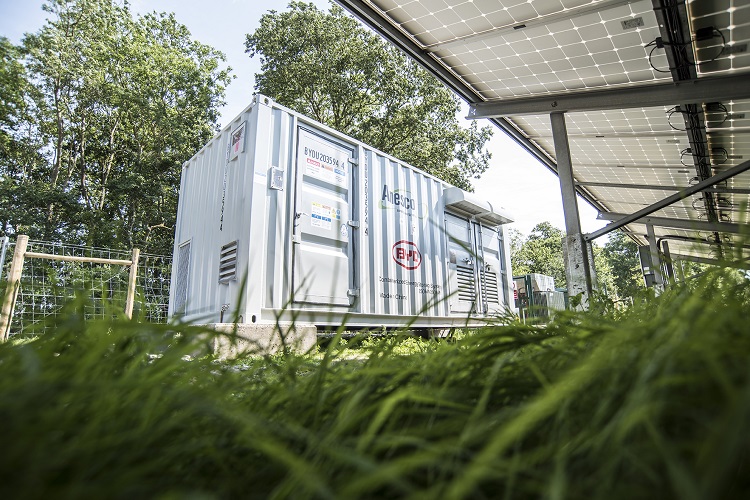Grid-scale
Battery developers race for Dutch grid access as TenneT unlocks 9 GW capacity
Dutch transmission system operator (TSO) TenneT has unlocked over 9 GW of high-voltage grid capacity by introducing flexible contracts for off-peak hours, prompting a surge of interest from battery energy storage developers eager to secure grid access. While these contracts offer notable advantages, Aurora Energy Research says that their overall impact on the battery storage business case will be limited.

By
Marija Maisch
Apr 14, 2025
Grid-scale
Markets
Policy
Projects & Applications

Image: Anesco
Last week’s announcement that Tennet is preparing for a large-scale introduction of time-dependent transmission right (TDTR) contracts in the Netherlands has offered a glimmer of hope to more than 70 GW of customers, mainly large-scale battery energy storage projects, currently stuck in the grid connection queue.
A new analysis by the Dutch TSO reveals that up to 9.1 GW of capacity is available on the high-voltage grid during off-peak hours—capacity that could be effectively utilized through TDTRs.
“Thanks to the new time-dependent contract, we can make more than 40% of the current national peak electricity demand available to interested customers on the waiting list. In the coming weeks we will be contacting all customers who have expressed an interest in the new product,” Tennet said.
The Dutch electricity grid is heavily saturated and almost in all parts of the country it reaches its maximum capacity during peak hours. Asa result, securing a grid connection has become increasingly difficult, with the waiting list growing exponentially in recent years.
To address this, TenneT has worked with a number of customers on the development of the TDTR product on a small scale over the past year. For example, Giga Storage was awarded the first TDTR contract for its 300 MW/1.2 GWh Leopard battery storage project in Delfzijl, and Lion Storage and TenneT recently signed a new contract of this kind in Vlissingen, Zeeland, for a 350 MW/1.4 GWh project.
TDTR give customers connected to the TenneT high-voltage grid the right to transport for a fixed number of hours per year, at least 85% of the time. This can be for the purchase as well as for the supply of electricity. During the remaining 15% of the time, TenneT can (partially) limit the purchase or feed-in of electricity, for example in the case of expected peak periods. Under the deal, TenneT should inform the customer of these restrictions at least one day in advance.
As such, TDTR is particularly interesting for companies that can use their energy flexibly, such as battery energy storage systems, the processing industry and companies with their own emergency facilities. According to TenneT’s calculations, flexible grid users can save up to 65% on grid tariffs through a combination of TDTR and intelligent use of time-dependent tariffs.
“We expect a lot of interest in the TDTR from battery developers. Our modelling of the battery dispatch revenues shows that the restrictions the contract type have on your dispatch are outweighed by the discount this provides on the grid fees for batteries,” Jesse Hettema, head of the Netherlands and Belgium at Aurora Energy Research, tells ESS News.
While strong demand for TDTR contracts is expected, their impact on the battery storage business case will be limited.
“Since there are a lot of developers looking to develop batteries, the 9 GW could easily be filled in by batteries, based on company ambitions. But we also see that even with the TDTR, the business case for batteries remains challenging and not all projects will be profitable enough to proceed,” Hettema says.
Battery storage projects in the Netherlands currently bear what is likely the highest grid fee burden in any European power market—a cost that has surged in recent years due to growing grid congestion. The introduction of TDTRs offers some relief, providing a 100% reduction in the fixed component of grid fees. However, it leaves the variable component untouched.
These variable fees—charged monthly based on a system’s peak import capacity—pose a greater challenge for battery energy storage optimization and value capture than the fixed charges. The encouraging news, however, is that grid fee policy reforms are already underway and expected to significantly lower the overall cost burden on battery storage in the near future.
“In our Central scenario, we see a strong growth in batteries, but only up to 1.5 GW towards 2030 based on current grid fee projections. For more projects to be profitable, further reductions in grid fees are necessary,” Hettema says.
TenneT anticipates that approximately 5 GW of large-scale battery storage projects will be connected to the grid by 2030, driven by the introduction of TDTRs. However, with over 70 GW of TDTR capacity currently in the application queue, many projects are likely to be left empty-handed. This is largely due to the fact that requested TDTR capacity far exceeds the Netherlands’ current peak electricity demand of around 19 GW—a figure expected to rise to only 27 GW by 2030.
The exact amount of the 9.1 GW of off-peak grid capacity that can be allocated hinges on the so-called ‘capacity puzzle’—a complex assessment of all applications and the availability of power at specific locations. As of last week, TenneT reported that 2.3 GW has already been assigned, with the remaining capacity to be distributed on a ‘first come, first served’ basis, while also factoring in broader social priorities.
ess-news.com |






